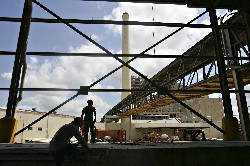
For those in Austin who don’t know, the EGRSO (the Economic Growth and Redevelopment Services Office… I had to look it up too) gets a substantial portion of its funding from the municipally-owned utility Austin Energy. What does this office do? From its city website:
[The EGRSO] implements the City of Austin Economic Development Policy as directed by the Austin City Council.
Essentially, the office provides grants and loans of city funds or services in order to promote economic development. Among its awardees are Facebook, LegalZoom, Heliovolt, Friday Night Lights, and the Home Depot Austin Technology Center.
Recently, the Electric Utility Commission voted unanimously to cut AE’s funding of the EGRSO, citing the fact that AE faces tough budget choices inside its own walls. Commissioner Shudde Fath wrote in the Business Journal that AE can no longer be the city’s cash cow.
EUC Chairman Phillip Schmandt released a statement on the matter yesterday:
I applaud EGRSO and its programs. There are many great ideas in EGROS’ $10 Million budget.
But not every great idea should be funded with government money.
And more to the point, not every great idea should be funded from utility bills paid by our hard working customers who are struggling to make ends meet every month. (more…)
 We held a press conference yesterday in San Antonio at the Pearl Brewery, which is currently being renovated and, upon its completion, will have the largest solar array panel in the state of Texas. Installed by Austin’s own Meridian Solar, the new system is expected to generate 25% of the energy needs for the new building, which will hold condos, an Aveda hair salon, and an art gallery.
We held a press conference yesterday in San Antonio at the Pearl Brewery, which is currently being renovated and, upon its completion, will have the largest solar array panel in the state of Texas. Installed by Austin’s own Meridian Solar, the new system is expected to generate 25% of the energy needs for the new building, which will hold condos, an Aveda hair salon, and an art gallery. What we have developed now is far from the sea of reflective solar panels in that unforgettable scene from Gattaca. New technology consists of a flexible sheet-like material that can simply be laid on top of already existing structures, such as the roofs of buildings. This particular type of solar technology is a branch of material called Photovoltaics (“PV”) that was actually first used to power satellites back in the 1950’s. The thin-film PV works the same way to convert energy derived from light into electricity, is only a few millionths of a meter thick, and now can be readily and easily installed onto almost any building.
What we have developed now is far from the sea of reflective solar panels in that unforgettable scene from Gattaca. New technology consists of a flexible sheet-like material that can simply be laid on top of already existing structures, such as the roofs of buildings. This particular type of solar technology is a branch of material called Photovoltaics (“PV”) that was actually first used to power satellites back in the 1950’s. The thin-film PV works the same way to convert energy derived from light into electricity, is only a few millionths of a meter thick, and now can be readily and easily installed onto almost any building.

